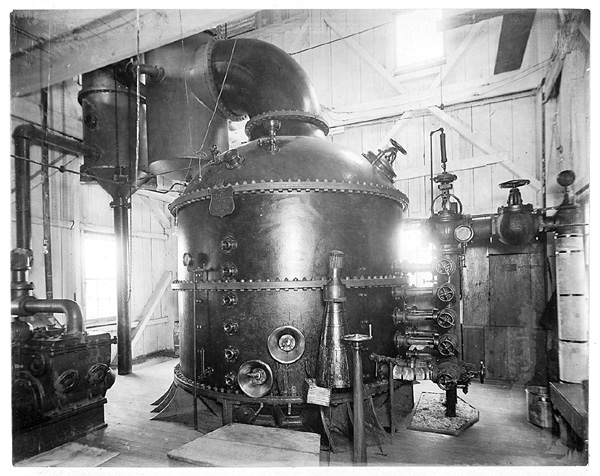
BIRTH OF THE MODERN INDUSTRY
The organization largely responsible for setting in motion the modernization of Louisiana's sugar industry was founded in 1877 by a group of prominent planters, among whom were John Dymond, Duncan F. Kenner, Henry McCall, and Edward J. Gay. The initial objective of the Louisiana Sugar Planters' Association (LSPA) was to lobby the federal government for favorable import tariffs, but the organization soon also became the chief proponent of scientific research and technological innovation in the Louisiana sugar industry. The LSPA espoused scientific and technological advancement as a means of facing increased foreign competition and it succeeded in attracting U.S. Department of Agriculture chemists to Louisiana in the 1880's to conduct studies on sugar production. In 1885, the LSPA sponsored the establishment of the state's first agricultural experiment station at Kenner and hired William Carter Stubbs (1846-1924) as director. The station's research was guided by agricultural and processing problems in the Louisiana sugar industry, and station staff frequently presented papers at the LSPA's monthly meetings. Following its move to Audubon Park in New Orleans in 1890, the Sugar Experiment Station was briefly at the forefront of research in sugar chemistry nationally and internationally. The first specialized school in the world for training experts for the cane sugar industry was founded at the Audubon Park station in 1891, with the station staff serving as the faculty. The Audubon Sugar School offered a two-year curriculum in agriculture, chemistry, and mechanical engineering that included both classroom and practical work. Financial difficulties forced the school to close in 1896, but its curriculum was incorporated into a degree program at LSU beginning in 1897.
Between 1880 and 1900, the Louisiana sugar industry underwent major transformations. Animal-powered mills and open kettles largely disappeared, and a sustained trend began toward fewer mills, larger cane acreages, and greater production using improved methods. Many sugar properties were incorporated as individual planters were unable to finance the operation of modern factories. Traditional plantation culture gave way to a separation of cane-growing from sugar manufacture. Central factories on large plantations began processing cane purchased from other growers together with their own. Louisiana faced increased competition from cane sugar imported from Cuba, Hawaii, and the Philippines, and debates over tariff reductions in the 1890's led to a partisan split in the Louisiana Sugar Planters' Association. The organization went into decline and ultimately merged with the American Cane Growers' Association in 1922, creating the American Sugar Cane League.
Items displayed in case 6:

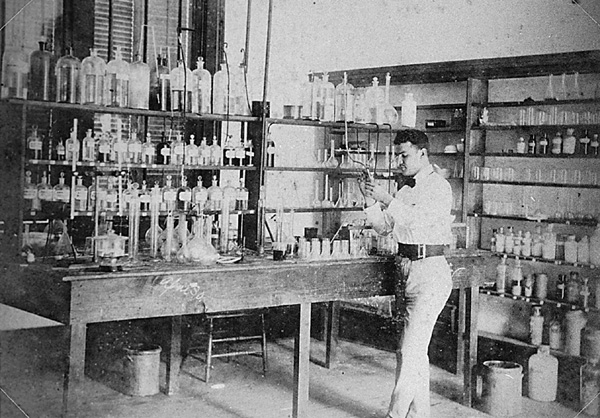
Two plates showing "The sugar industry of Louisiana," drawings by J.O. Davidson. Reproduced from: Harper's Weekly, July 21 and 28, 1883. Rare Flat 051 H234
Annual Announcement and Catalogue of the Audubon Park Sugar School, 1893-94. Louisiana Collection S537 L82
William Carter Stubbs. Sugar Cane : A Treatise on its History, Botany and Agriculture. Savannah, D.G. Purse, 1901. Louisiana Collection SB231 S93 pt.1-2, c.2
Guilford L. Spencer. Report of Experiments in the Manufacture of Sugar by Diffusion. Washington, Government Printing Office, 1889. Louisiana Collection TP375.8 U6 S74 1889
Louisiana Sugar Planters' Association. Regular Monthly Meeting, August 1887. New Orleans, 1887. Louisiana Collection SB215 L6863
Louisiana Agricultural Experiment Station. Bulletin, no. 20. Baton Rouge, 1889. Louisiana Collection S67 E36, series 1.
AN INDUSTRY UNDER SIEGE
Louisiana's sugar industry was ravaged and nearly wiped out by the mosaic virus in the early 1900's. Sugar production had reached an all-time high of nearly 400,000 tons in 1904, but by 1926 it had bottomed out at less than 50,000 tons. While most sugar planters were slow to react to this insidious threat to their industry, a few, most notably Southdown Plantation, recognized the urgency of the situation and began fighting back. Salvation came in the form of disease-resistant varieties of sugarcane which had been imported from Java by the U.S. Department of Agriculture (USDA). Named for their point of origin, the Proefstation Oost Java (East Java Experimental Station), they were known as P.O.J. varieties. Southdown requested and received three such varieties (P.O.J. 36, 213, and 234) from the USDA in 1922 and 1923. Fears that the varieties might not be suitable for Louisiana's subtropical climate were quickly quelled as they performed exceedingly well during testing.
In 1925, Southdown made P.O.J. 234 available to sugar planters throughout the state, and for the next few years, the Louisiana Experiment Stations, the USDA, and the American Sugar Cane League worked in concert to encourage planters to adopt the new disease-resistant varieties. Although the P.O.J. varieties only dominated for a few years until the breeding program took hold, they are credited with bringing the industry back from the brink of extinction.
Items displayed in case 7:
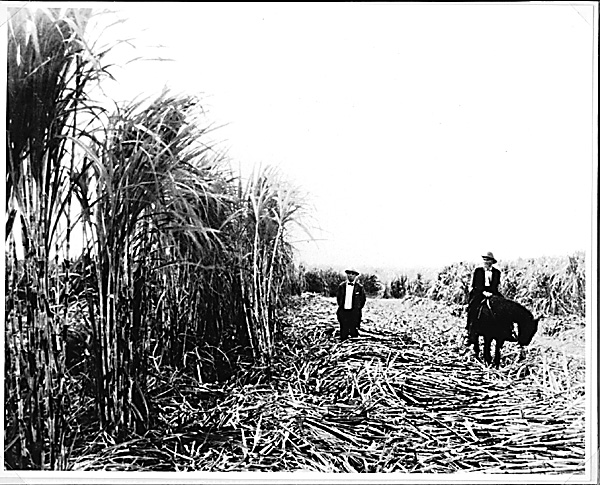
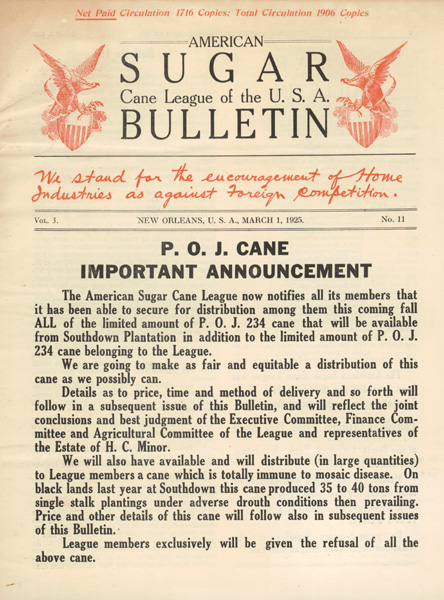
P.O.J. 234, Hollywood Plantation, Terrebonne Parish, November, 1924. Reproduced from: Henry C. Minor Estate Partnership Papers, Mss. 1509, Louisiana and Lower Mississippi Valley Collections
Thorton Cane Storage 80 ft. Steel Derrick at Geo. M. Murrells, Iberville Parish. Reproduced from: Edward J. Gay and Family Papers, Mss. 1295, Louisiana and Lower Mississippi Valley Collections
Baton Rouge Sugar Refinery, near University, 1899. Reproduced from: LSU Photograph Collection, Audubon Sugar School, Louisiana and Lower Mississippi Valley Collections
View of field including plantation railroad, Southdown Plantation. Reproduced from: Henry C. Minor Estate Partnership Papers, Mss. 1509, Louisiana and Lower Mississippi Valley Collections
View of Southdown Refinery from Dairy. Reproduced from: Henry C. Minor Estate Partnership Papers, Mss. 1509, Louisiana and Lower Mississippi Valley Collections
View of Bagasse Shipping Shed, Celotex Co., Southdown Refinery, Terrebonne Parish, 1923. Reproduced from: Henry C. Minor Estate Partnership Papers, Mss. 1509, Louisiana and Lower Mississippi Valley Collections
Aerial view of Southdown, 1923. Reproduced from: Henry C. Minor Estate Partnership Papers, Mss. 1509, Louisiana and Lower Mississippi Valley Collections
Photograph of auction of first sugar made in Louisiana from P.O.J. cane at the New Orleans Sugar Exchange, October, 1927. Reproduced from: Henry C. Minor Estate Partnership Papers, Mss. 1509, Louisiana and Lower Mississippi Valley Collections
Donaldsonville Fair, October, 1928 "Terrebonne, Home of P.O.J. Cane." Reproduced from: Henry C. Minor Estate Partnership Papers, Mss. 1509, Louisiana and Lower Mississippi Valley Collections
"We're engaged to be married!" New Orleans Times-Picayune Cartoon, November 3, 1929. Henry C. Minor Estate Partnership Papers, Mss. 1509, Louisiana and Lower Mississippi Valley Collections
Louisiana Hails P.O.J. Illinois Central System Publication. Henry C. Minor Estate Partnership Papers, Mss. 1509, Louisiana and Lower Mississippi Valley Collections
LSU STEPS IN
When William C. Stubbs, the original Director of the Audubon Sugar School, recommended that the School be closed in the fall of 1896, it was not without a plan. Although the School had never been a financial success and had proven a burden to his research staff, who had also served as the faculty for the School, he recognized the need for such an institution. However, he thought that the Sugar Experiment Station should focus on research, and that the teaching should be left to others. He lost little time in proposing that LSU incorporate the School's curriculum into a degree program. In a seven-page letter, he laid out a series of recommendations as to the direction he thought the program should take, including significant changes to the curriculum.
LSU President Thomas D. Boyd and the LSU Board of Supervisors agreed that the School should be brought under the auspices of LSU. It was placed in the capable hands of Dr. Charles E. Coates, who served as Director until 1937, and was reopened in the fall of 1897. With changing leadership came a corresponding shift in the curriculum. Emphasis moved from agriculture to chemical and mechanical engineering, as students followed one of two courses of study: sugar agriculture and chemistry; or sugar chemistry and engineering. The five-year program consisted of three years of classroom instruction at LSU's campus in Baton Rouge and two years of practical instruction in sugar technology at the Sugar Experiment Station in Audubon Park. Although the students' time was split between the two locations, the School's physical location remained at Audubon Park until 1925, when the entire program, along with the Sugar Experiment Station, was relocated to Baton Rouge.
Items displayed in case 8:
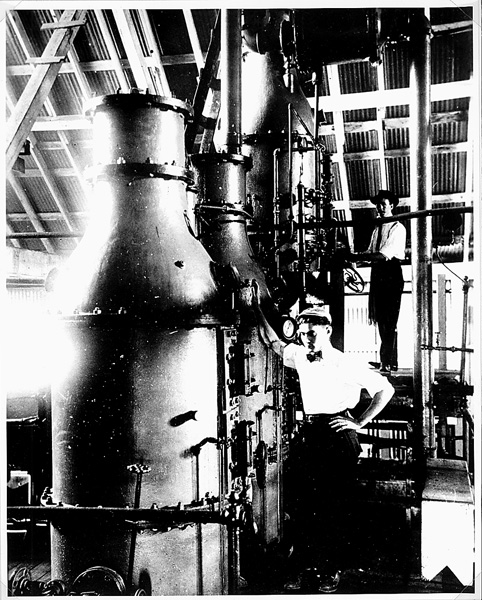

Photograph of Chemistry Lab, Audubon Park, 1899. Reproduced from: LSU Photograph Collection, Audubon Sugar School, Louisiana and Lower Mississippi Valley Collections
Photograph of the Interior of Engineering Lab. Reproduced from: LSU Photograph Collection, Audubon Sugar School, Louisiana and Lower Mississippi Valley Collections
At the Small Pan. Reproduced from: Charles E. Coates Papers, Mss. 2283, Louisiana and Lower Mississippi Valley Collections
Photograph of sugar students at work, Audubon Park, 1902. Reproduced from: LSU Photograph Collection, Audubon Sugar School, Louisiana and Lower Mississippi Valley Collections
William C. Stubbs's Letter to LSU President Thomas D. Boyd, dated November 11, 1896, proposing that LSU incorporate the Audubon Sugar School. William C. Stubbs Letter, Mss. 2283, Louisiana and Lower Mississippi Valley Collections
1897/98 Audubon Sugar School Catalogue (first year program was under LSU). Louisiana Collection S537 L82
"Performance Tests of Sugar House Heating and Evaporating Apparatus," in Louisiana Bulletin No.149 (August, 1914). Courtesy of Audubon Sugar Institute
Mundinger, A. G., The Manufacture of Sugar by the Roller Process. 1902. LSU Collection, Bachelor's Theses, Louisiana and Lower Mississippi Valley Collections
Zinc printer's plate (with print) for "Golden Tiger Syrup" labels, Audubon Sugar School, circa 1930's. Plate loaned by LSU Rural Life Museum. Print courtesy of Elaine Smyth
CHANGING WITH THE TIMES
The Louisiana Sugar Planters' Association, the American Cane Growers' Association, and the Producers' and Manufacturers' Protective Association merged in 1922 to create the American Sugar Cane League, which was organized to provide the leadership sorely needed by the industry.
LSU provided a complementary source of training for leadership. In 1925, the Sugar Experiment Station and the Audubon Sugar School and Factory were relocated to the new LSU campus in Baton Rouge. The School had made quite a name for itself, with its graduates holding top management positions worldwide. In 1938, LSU's selection as host of the sixth congress of the International Society of Sugar Cane Technologists paid homage to its status as an international force within the industry. The sixty-seven delegates from Louisiana included such notables as Charles E. Coates, E. W. Kerr, Arthur G. Keller, and William G. Taggert. LSU repeated as host when the fourteenth congress was held in New Orleans in 1971.
The School continued to churn out graduates and the Sugar Factory remained a working entity until the mid-1960's, when the program was derailed by the Cuban Revolution. As Cuban exiles, many with years of experience in the sugar industry, flooded the United States, Sugar School graduates suddenly began having difficulty finding jobs. The 1970's saw the demise of the Sugar School and the birth of the Audubon Sugar Institute in 1976. The Institute was created to serve the state sugar industry, and has been instrumental in sustaining research and promoting communication throughout the state.
Items displayed in case 9:
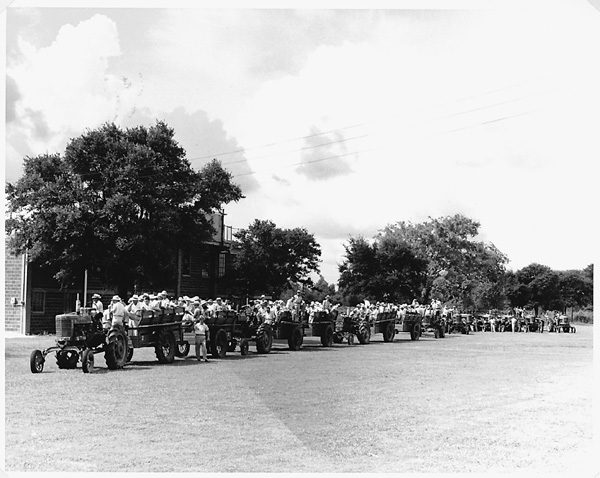
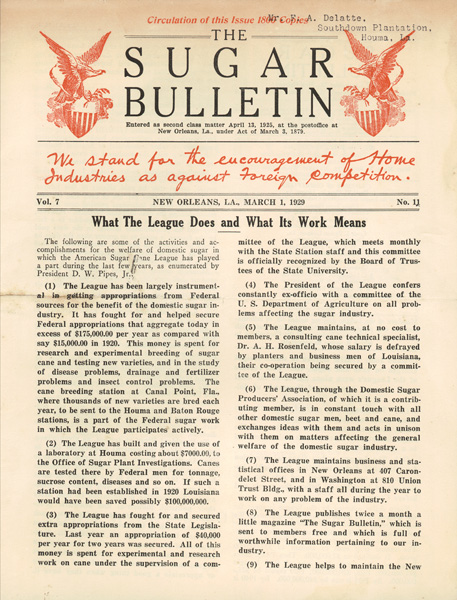
Audubon Sugar Factory in commercial operation in the 1960's. Courtesy of Audubon Sugar Institute
Audubon Sugar Factory at LSU campus in Baton Rouge, 1926. Courtesy of Audubon Sugar Institute
Photograph of Special Sugar Exhibit in U. S. Exhibit of Agricultural Colleges, Louisiana Purchase Exposition, St. Louis, Missouri, 1904, reproduced from Louisiana at Louisiana Purchase Exposition. New Orleans: American Printing Co., 1904. Louisiana Collection T860 F3 L8
Jar of "La cuite" (from the French word meaning "cooked"), Audubon Sugar Institute, 1970's. Loan, LSU Rural Life Museum
Handbook, Sixth Congress of the International Society of Sugar Cane Technologists, Baton Rouge, Oct. 24-Nov. 5, 1938. Louisiana Collection TP375 I5 1938d c.1
"Investigations on the Sugar Cane Disease Situation in 1925 and 1926," in Louisiana Bulletin No. 197 (April, 1927). Courtesy of Audubon Sugar Institute
Delegates from Louisiana, reproduced from International Society of Sugar Cane Technologists, Proceedings of the Sixth Congress, held at Louisiana State University, Baton Rouge, Louisiana, October 24 to November 5, 1938. Louisiana Collection TP375 I456 1938 c.7
Raising Cane in Louisiana. American Sugar Cane League Publication. Courtesy of Audubon Sugar Institute
